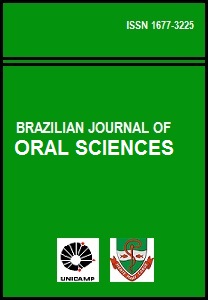Abstract
Aim: This study evaluated the adaptation of cast metal cores (CMCs) using two impression materials and two intracanal impression techniques. Methods: Ten single-rooted human teeth had their root canals prepared to receive a CMC. Intracanal impressions were obtained with addition and condensation silicone materials using two types of intraradicular supports: hypodermic needle or prefabricated polycarbonate posts. Four impressions were obtained from each tooth totalizing 40 models, on which CMCs were prepared. CMC adaptation to the canal was analyzed radiographically and microscopically. The teeth were radiographed with the CMC positioned and the images were analyzed using an image-analysis software (ImageLab). In the second analysis, the teeth were sectioned longitudinally and the CMC adaptation was evaluated with a two-coordinate microscope. In both analyses, CMC adaptation to the canal was determined by calculating the percentage of the prepared canal space that was occupied by the core. Results: Statistically significant difference (2-way ANOVA - Bonferroni; p<0.05) was found between the mean values CMC adaptation obtained with the two intraradicular supports. Conclusions: The intracanal impression technique using hypodermic needle allowed a more accurate reproduction of the prepared canal space and provided significantly better CMC adaptation when the cores were obtained from addition silicone impressions.The Brazilian Journal of Oral Sciences uses the Creative Commons license (CC), thus preserving the integrity of the articles in an open access environment.
Downloads
Download data is not yet available.

